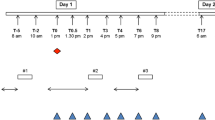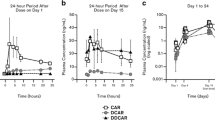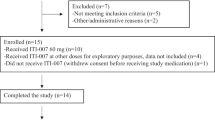Abstract
SCH 39166 is the first selective D1-dopamine receptor antagonist developed for clinical trials in schizophrenia. SCH 39166 was evaluated as a radioligand for PET, labeled with11C, and as a D1-dopamine receptor antagonist after single oral doses in healthy men. After intravenous injection of [11C]SCH 39166 distribution of radioactivity in brain grossly reflected D1-dopamine receptor density. The putamen to cerebellum ratio at equilibrium was low (1.54±0.18 SD), which makes [11C]SCH 39166 less suitable as a radioligand for applied PET studies. Saturability of specific binding was demonstrated after IV injection of [11C]SCH 39166 with low specific radioactivity. Stereospecificity of binding was examined using the stereoisomer [11C]SCH 39165. D1-Receptor occupancy was demonstrated with [11C]SCH 39166 2 h after administration of single oral doses of unlabeled SCH 39166 to each of three healthy subjects (25, 100 and 400 mg). There was a substantial reduction of specific [11C]SCH 39166 uptake in the putamen after all doses. Single oral doses of 100 mg induced approximately 70% D1-dopamine receptor occupancy in the basal ganglia, which should be sufficient to investigate the antipsychotic potential of D1-dopamine receptor antagonism in clinical studies.
Similar content being viewed by others
References
Berger JG, Chang WK, Clader JW, Hou D, Chipkin RE, McPhail AT (1989) Synthesis and receptor affinities of some conformationally restricted analogues of the dopamine D1 selective ligand (5R)-8-chloro-2,3,4,5,tetrahydro-3-methyl-5-phenyl-1H-3-benzazepin-7-ol. J Med Chem 32:1913–1921
Bergström M, Boëthius J, Eriksson L, Greitz T, Ribbe T, Widén L (1981) Head fixation device for reproducible position alignment in transmission CT and positron emission tomography. J Comput Assist Tomogr 5:136–141
Chipkin RD, Iorio LC, Coffin VL, McQuade RD, Berger JG, Barnett A (1988) Pharmacological profile of SCH 39166: a dopamine D1 selective benzonaphtazepine with potential antipsychotic activity. J Pharmacol Exp Ther 247:1093–1102
Clark D, White FJ (1987) Review: D1 dopamine receptor — the search for a function: a critical evaluation of the D1/D2 dopamine receptor classification and its functional implications. Synapse 1:347–388
Cortés R, Gueye B, Pazos A, Probst A, Palacios JM (1989) Dopamine receptors in human brain: autoradiographic distribution of D1 sites. Neuroscience 28:263–273
DeKeyser J, Claeys A, DeBacker J-P, Ebinger G, Roels F, Vauquelin G (1988) Autoradiographic localization of D1 and D2 dopamine receptors in the human brain. Neurosci Lett 91:142–147
Farde L (1992) Selective D1- and D2-dopamine receptor blockade both induce akathisia in humans - a PET study with [11C]SCH 23390 and [11C]raclopride. Psychopharmacology 107:23–29
Farde L, Eriksson L, Blomquist G, Halldin C (1989) Kinetic analysis of central [11C]raclopride binding to D2-dopamine receptors studied by PET — a comparison to the equlibrium analysis. J Cereb Blood Flow Metab 9:696–708
Farde L, Halldin C, Stone-Elander S, Sedvall G (1987) PET analysis of human dopamine receptor subtypes using11C-SCH 23390 and11C-raclopride. Psychopharmacology 92: 278–284
Farde L, Nordström A-L, Nyberg S, Halldin C, Sedvall G (1994) D1-, D2- and 5-HT2-receptor occupancy in clozapine-treated patients. J Clin Psychiatry 55: 67–69
Farde L, Nordström A-L, Wiesel F-A, Pauli S, Halldin C, Sedvall G (1992) PET-analysis of central D1- and D2-dopamine receptor occupancy in patients treated with classical neuroleptics and clozapine — relation to extrapyramidal side effects. Arch Gen Psychiatry 49: 538–544
Farde L, Pauli S, Hall H, Eriksson L, Halldin C, Högberg T, Nilsson L, Sjögren I, Stone-Elander S (1988a) Stereoselective binding of11C-raclopride binding in living human brain — a search for extrastriatal D2-dopamine receptors by PET. Psychopharmacology 94: 471–478
Farde L, Wiesel F-A, Halldin C, Sedvall G (1988b) Central D2-dopamine occupancy in schizophrenic patients treated with antipsychotic drugs. Arch Gen Psychiatry 45: 71–76
Giacomini J, Nelson W, Theodore L, Wong F, Rood D, Giacomini K (1985) The pharmacokinetics and pharmacodynamics of d-and dl-verapamil in rabbits. J Cardiovasc Pharmacol 7: 469–475
Hall H, Farde L, Sedvall G (1988) Human dopamine receptor sub-types — in vitro binding analysis using3H-SCH 23390 and3H-raclopride. J Neural Transm 73: 7–21
Hall H, Halldin C, Sedvall G (1993) Binding of [3H]SCH 39166 to human post mortem brain tissue. Pharmacol Toxicol 72: 152–158
Halldin C, Farde L, Barnett A, Sedvall G (1991) Synthesis of carbon-11 labelled SCH 39166, a new selective dopamine D-1 receptor ligand, and preliminary PET investigations. Appl Radiat Isot 42: 451–455
Halldin C, Stone-Elander S, Farde L, Ehrin E, Fasth K-J, Långström B, Sedvall G (1986) Preparation of11C-labelled SCH 23390 for the in vivo study of dopamine D-1 receptors using positron emission tomography. Appl Radiat Isot 37: 1039–1043
Hyttel J (1983) SCH23390 — the first selective dopamine D1-antagonists antagonist. Eur J Pharmacol 91: 153–154
Iorio L (1981) A benzazepine with atypical effects on dopaminergic systems. Pharmacologist 23: 136
Karlsson P, Farde L, Halldin C, Sedvall G, Ynddal L, Sloth-Nielsen M (1995) Oral administration of NNC 756 — a placebo controlled PET study of D1-dopamine receptor occupancy and pharmacodynamics in man. Psychopharmacology 119: 1–8
Litton JE, Holte S, Eriksson L (1990) Evaluation of the Karolinska new positron camera system; the Scanditronix PC2048-15B. IEEE Trans Nucl Sci 37: 743–748
McQuade RD, Duffy RA, Coffin VL, Chipkin RE, Barnett A (1991) In vivo binding of SCH-39166 — a D-1 selective antagonist. J Pharmacol Exp Ther 257: 42–49
Nielsen EB, Andersen PH (1992) Dopamine receptor occupancy in vivo: behavioral correlates using NNC-112, NNC-687 and NNC-756, new selective dopamine D1 receptor antagonists. Eur J Pharmacol 219: 35–44
Olanoff L, Walle T, Walle K, Cowart T, Gaffeny T (1984) Stereoselective clearance and distribution of intravenous propranolol. Clin Pharmacol Ther 35: 755–761
Sedvall G, Farde L, Stone-Elander S, Halldin C (1986) Dopamine D1-receptor binding in the living human brain. In: Breese GR, Creese I (eds) Neurobiology of central D1-dopamine receptors. Plenum, New York, pp 119–124
Sedvall G, Farde L, Barnett A, Hall H, Halldin C (1991a)11C-SCH 39166, a selective ligand for visualization of dopamine-D1 receptor binding in the monkey brain using PET. Psychopharmacology 103: 150–153
Sedvall G, Karlsson P, Lundin A, Anvret M, Suhara T, Halldin C, Farde L (1994) Dopamine D1-receptor number — a sensitive PET marker for early brain degeneration in Huntington's disease. Eur Arch Psychiatry Clin Neurosci 243: 249–255
Seeman P (1987) The absolute density of neurotransmitter receptors in the brain. J Pharmacol Methods 17: 347–360
Seeman P, Lee T, Chau-Wong M, Wong K (1976) Antipsychotic drug doses and neuroleptic/dopamine receptors. Nature 261: 717–719
Swahn C-G, Halldin C, Farde L, Sedvall G (1994) Metabolism of the PET ligand [11C] SCH 23390. Identification of two radiolabelled metabolites with HPLC. Hum Psychopharmacol 9: 25–31
Thijssen H, Baars L, Drittij-Reijnders J (1985) Stereoselective aspects in the pharmacokinetics and pharmacodynamics of acenocumarol and its amino and acetamide derivatives in the rat. Drug Metab Dispos 13: 593–597
Van Rossum JM (1966) The significance of dopamine receptor blockade for the mechanism of action of neuroleptic drugs. Arch Int Pharmacodyn Ther 160: 492–494
Waddington JL, Daly SA, McCauley PG, O'Boyle KM (1994) Levels of functional interaction between D1-like and D2-like dopamine receptor systems. In: Niznik HB (ed) Dopamine receptors and transporters. Marcel Dekker, New York, pp 511–537
Wong D, Gjedde A, Wagner H Jr (1986a) Quantification of neuroreceptors in the living human brain I. Irreversible binding of ligands. J Cereb Blood Flow Metab 6: 137–146
Wong D, Gjedde A, Wagner H Jr (1986b) Quantification of neuroreceptors in the living human brain II. Inhibition studies of receptor density and affinity. J Cereb Blood Flow Metab 6: 146–159
Author information
Authors and Affiliations
Rights and permissions
About this article
Cite this article
Karlsson, P., Sedvall, G., Halldin, C. et al. Evaluation of SCH 39166 as PET ligand for central D1 dopamine receptor binding and occupancy in man. Psychopharmacology 121, 300–308 (1995). https://doi.org/10.1007/BF02246067
Received:
Revised:
Issue Date:
DOI: https://doi.org/10.1007/BF02246067




